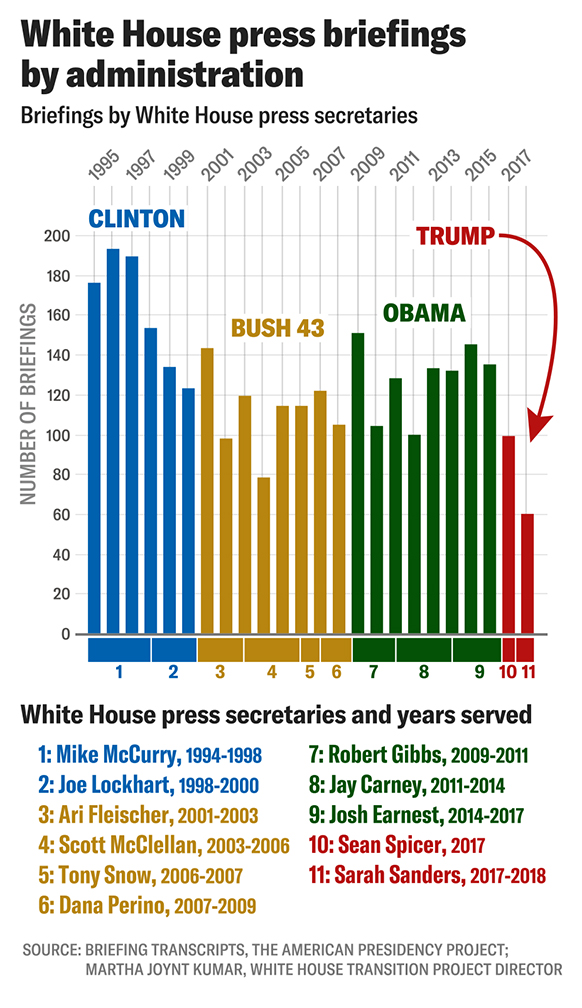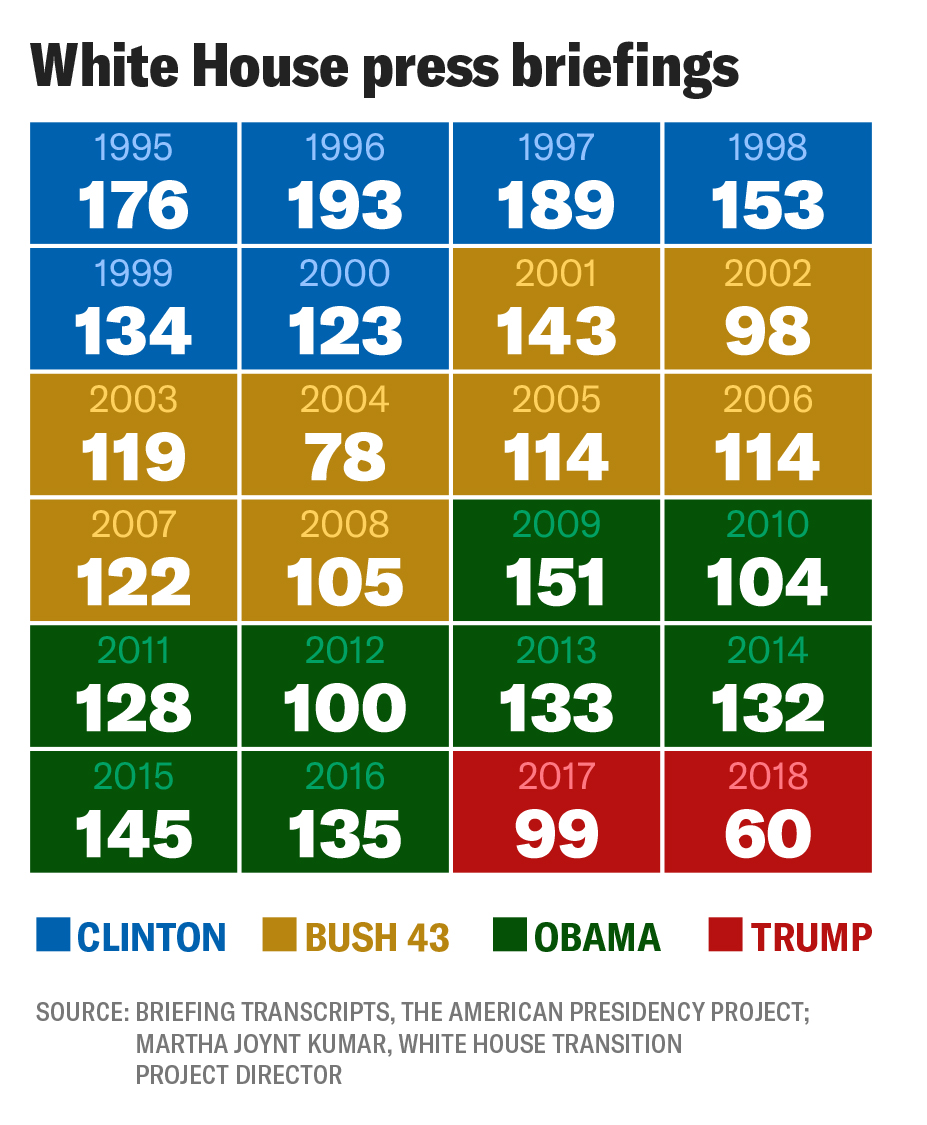The number of White House press briefings has slumped under President Trump to the lowest level since they took on their modern format nearly a quarter-century ago.
With Trump routinely denouncing the media as “fake news” and many press outlets — as well as some White House news correspondents — habitually calling him a liar and predicting his impeachment, relations between reporters and the White House have reached rock bottom.
At the same time, Trump has taken to acting as his own press secretary, communicating directly with the media. He has also circumvented the press by appealing directly to the public via Twitter, where he currently has 57.4 million followers, sending 3,381 tweets last year.
Many journalists and former White House officials view the demise of the press briefing as an ominous development. “It’s corrosive to what we think of as American democracy that you don’t have the ability to hold the people in power accountable. That’s very, very troubling to me personally,” former White House press secretary Mike McCurry told the Washington Examiner.
“I did my fair amount of spin and moving and grooving, that’s what you do. But at the same time, we worked very hard to assemble the information we needed to convey every day.” It was McCurry who, in 1995, introduced the fully televised press briefing.
Last year, Trump’s press secretary, Sarah Sanders, took to the podium fewer times than any of her predecessors since briefings were first fully televised in 1995. During the second half of 2018, she all but vanished.
In 2018, she held a total of 60 briefings with just 13 of those between July and December. In the months of September, November, and December, Sanders took the podium just once each month. So far this year, Sanders has yet to hold a briefing.
The last press briefing was on Dec. 18, 34 days ago. The previous longest period under any recent president without a press briefing was 29 days between October and November last year.
On Tuesday, Trump tweeted: “The reason Sarah Sanders does not go to the ‘podium’ much anymore is that the press covers her so rudely & inaccurately, in particular certain members of the press. I told her not to bother, the word gets out anyway! Most will never cover us fairly & hence, the term, Fake News!”
Briefings held by Sanders typically last less than 20 minutes, according to data compiled by White House Transition Project Director Martha Joynt Kumar, who tracks White House communications. Previous press secretaries generally spent more time taking questions — in some cases, for two or three times as long.

“It’s a record low” number of briefings, Kumar told the Washington Examiner, adding, “The briefing was traditionally the reporters’ forum. The reporters were the ones who called an end to the briefing, not the press secretary.” Sanders’ appearances at the podium hit a high in October 2017, when she held 12 briefings with the press — still not particularly many by the standards of previous press secretaries.
During his tenure working for former President Bill Clinton, McCurry held more than 190 briefings in one year — 1996 — according to a review of briefing transcripts compiled by the American Presidency Project.
McCurry didn’t shy away from the press, even when the scandal involving former White House intern Monica Lewinsky was dominating the headlines. He and his successor, Joe Lockhart, held 153 press briefings in 1998.
He recalled during that time period telling reporters he was “double-parked in the no-comment zone on Monica Lewinsky” before going on to field queries on other topics.
“That goes with the job,” McCurry said. “You’ve got to deal with whatever the headlines are, even if you’re at the White House and think this is all kind of tawdry business, then you try to get back to the things that are fundamentally important.”
Former White House press secretaries for Presidents George W. Bush, Barack Obama, and Clinton typically held at least 100 White House press briefings each year. That number would fall during election years.

Trump speaks frequently with the press himself, often far more times over the course of a week than his recent predecessors. Trump had more than 300 exchanges — interviews, question-and-answer sessions, and press conferences — with the media in 2018, according to Kumar’s data, and the frequency of Sanders’ briefings is tied to the president’s own accessibility.
Sanders, who did not return a request for comment, defended the frequency of briefings last year, telling Fox News it is better for the White House press corps to question Trump than her. “I always think if you can hear directly from the president, and the press has a chance to ask the president of the United States questions directly, that’s infinitely better than talking to me,” she said in October.
Fleischer said the president taking questions from reporters is “superior to a briefing,” but that the briefing can still play a critical role in informing the public.
“I’m old school,” he told the Washington Examiner. “I continue to think the briefing can be helpful in a normal environment where there wasn’t so much animosity.” Sanders’ press briefings can be acrimonious and are often carried live by the networks. But the combative exchanges she has with some reporters have raised questions about the format.
Fleischer and McCurry have urged the White House to cease televising the briefings.
[Opinion: At the White House press briefings, everyone loses]
“Except on rare news days, the briefings should not be a red hot news event. It should not be a moment in and of itself,” Fleischer said. “It should be one of many moments where reporters gather information so they can write stories. But in our hyped up, everything-including-a-cat-stuck-up-a-tree-is-breaking-news, this-just-in media hype, the briefing has turned into something it was never intended to be.
“As a former press secretary and as somebody who believes in good government, transparency, and who enjoyed my relationships with the media, I see a lot of value in the briefing,” he said. “On the other hand, as a realist guided by the unproductive and fierce hostility that the press has toward the president, and as reciprocated by the president toward the press, what good does a briefing do anymore?”
McCurry said it was “lamentable” that reporters don’t have a regular forum through which they can question someone who speaks on behalf of the president. “A briefing that ensures a regular, routine opportunity for the press, representing the American people, to actively engage the White House about policy and programs and issues is indispensable,” McCurry said. “It’s a requirement of our democracy in many ways.”

